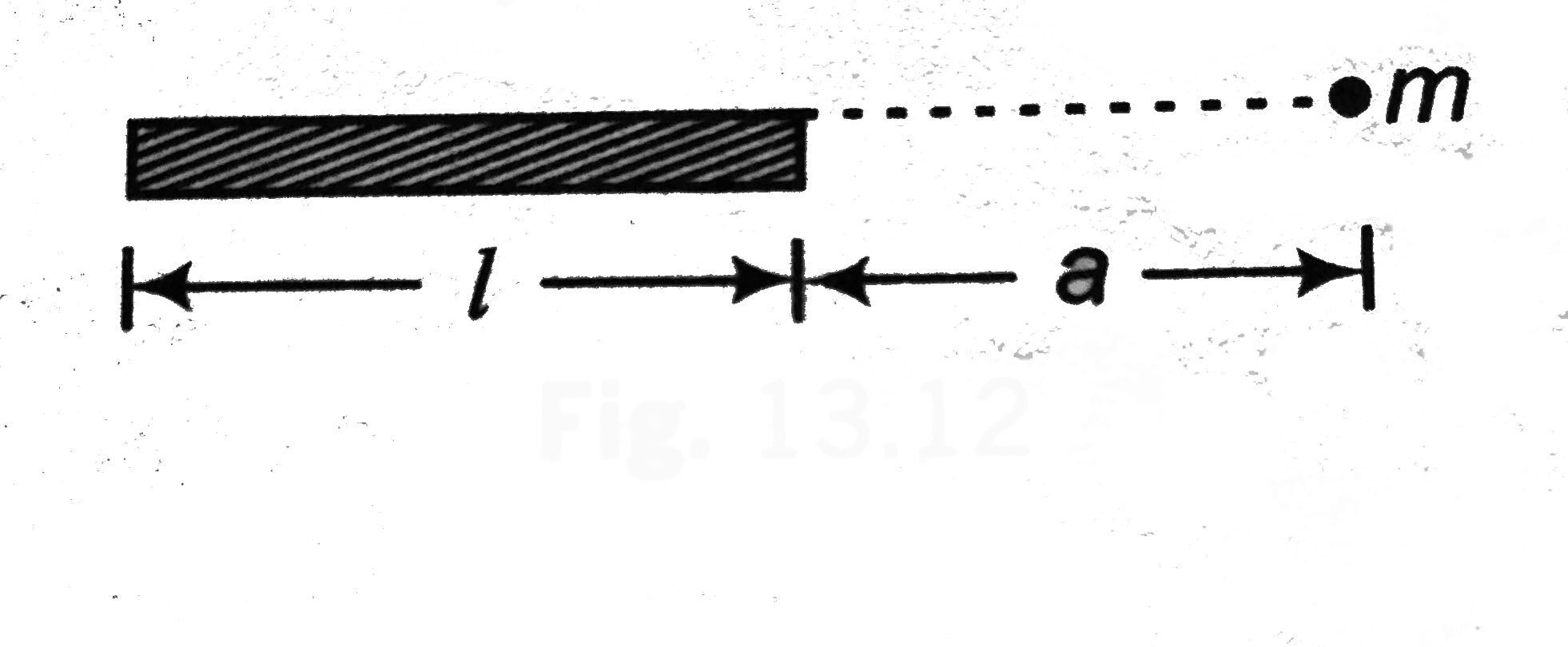A semicircular wire has a length L and mass M. A particle of mass m is placed at the center of the circle. Find the gravitational attraction on the particle due to the wire.
The correct Answer is:B
To find the gravitational attraction on a particle of mass m placed at the center of a semicircular wire of length L and mass M, we can follow these steps:
Step 1: Define the Geometry
Assume the semicircular wire is centered at the origin of a coordinate system, with its ends touching the x-axis. The radius R of the semicircle can be expressed in terms of the length L as:
R=Lπ
Step 2: Determine the Incremental Mass
Consider an infinitesimal element of the wire at an angle θ with respect to the x-axis. The length of this infinitesimal element is given by:
dL=Rdθ
The mass of this infinitesimal element dm can be expressed as:
dm=ML⋅dL=ML⋅Rdθ=ML⋅Lπdθ=Mπdθ
Step 3: Calculate the Gravitational Force by the Element
The gravitational force dF exerted by the mass element dm on the particle of mass m at the center is given by Newton's law of gravitation:
dF=GmdmR2
Substituting dm:
dF=Gm⋅Mπdθ(Lπ)2=GmMπL2dθ
Step 4: Resolve the Force into Components
The force dF can be resolved into its x and y components. The x-component is dFx=dFcosθ and the y-component is dFy=dFsinθ:
dFx=GmMπL2cosθdθ
dFy=GmMπL2sinθdθ
Step 5: Integrate to Find Total Force
To find the total gravitational force, we integrate dFx and dFy over the limits 0 to π:
Fx=∫π0dFx=GmMπL2∫π0cosθdθ
Fy=∫π0dFy=GmMπL2∫π0sinθdθ
Calculating these integrals:
- The integral of cosθ from 0 to π is 0.
- The integral of sinθ from 0 to π is 2.
Thus, we have:
Fx=0
Fy=GmMπL2⋅2=2GmMπL2
Step 6: Final Result
The total gravitational force F acting on the particle is directed in the positive y-direction (towards the wire) and has a magnitude of:
F=0^i+2GmMπL2^j
Conclusion
The gravitational attraction on the particle due to the semicircular wire is:
F=2GmMπL2^j
Assume the semicircular wire is centered at the origin of a coordinate system, with its ends touching the x-axis. The radius R of the semicircle can be expressed in terms of the length L as:
R=Lπ
Consider an infinitesimal element of the wire at an angle θ with respect to the x-axis. The length of this infinitesimal element is given by:
dL=Rdθ
The mass of this infinitesimal element dm can be expressed as:
dm=ML⋅dL=ML⋅Rdθ=ML⋅Lπdθ=Mπdθ
The gravitational force dF exerted by the mass element dm on the particle of mass m at the center is given by Newton's law of gravitation:
dF=GmdmR2
Substituting dm:
dF=Gm⋅Mπdθ(Lπ)2=GmMπL2dθ
The force dF can be resolved into its x and y components. The x-component is dFx=dFcosθ and the y-component is dFy=dFsinθ:
dFx=GmMπL2cosθdθ
dFy=GmMπL2sinθdθ
To find the total gravitational force, we integrate dFx and dFy over the limits 0 to π:
Fx=∫π0dFx=GmMπL2∫π0cosθdθ
Fy=∫π0dFy=GmMπL2∫π0sinθdθ
- The integral of cosθ from 0 to π is 0.
- The integral of sinθ from 0 to π is 2.
Fx=0
Fy=GmMπL2⋅2=2GmMπL2
The total gravitational force F acting on the particle is directed in the positive y-direction (towards the wire) and has a magnitude of:
F=0^i+2GmMπL2^j
The gravitational attraction on the particle due to the semicircular wire is:
F=2GmMπL2^j
Topper's Solved these Questions
- BOOK - HC VERMA ENGLISHCHAPTER - GRAVITATIONEXERCISE - Question for short Answers18videos
GRAVITATION
- BOOK - HC VERMA ENGLISHCHAPTER - GRAVITATIONEXERCISE - Objective -26videos
GRAVITATION
- BOOK - HC VERMA ENGLISHCHAPTER - FRICTIONEXERCISE - Questions for short Answer11videos
FRICTION
- BOOK - HC VERMA ENGLISHCHAPTER - HEAT AND TEMPERATUREEXERCISE - Objective 26videos
HEAT AND TEMPERATURE
Similar Questions
A semicircular wire has a length L and mass M. A particle of mass m is placed at the centre of the circle. Find the gravitational attraction on the particle due to the wire.
View SolutionA semicircular wire hs a length L and mass M. A paricle of mass m is placed at the centre of the circle. Find the gravitational attraction on the particle due to the wire.
View Solution
Knowledge Check
- Question 1 - Select One
A particle of mass m is placed at the centre of a unifrom spherical shell of mass 3 m and radius R The gravitational potential on the surface of the shell is .
AGMRB−GMRC−4GMRD−2GMR
A semicircular wire has a length L and mass M. A particle of mass m is placed at the centre of the circle. Find the gravitational attraction on the particle due to the wire.
View SolutionFour particles each of mass 'm' are placed at the four vertices of a square 'a' .Find net force on any one the particle.
View SolutionA mass m is at a distance a from one end of a uniform rod of length l and mass M. Find the gravitational force on the mass due to the rod.
 View Solution
View SolutionEight particles of mass 'm' each are placed at the verties of a cube of side 'a' . Find gravitational potential energy of this system .
 . View Solution
. View SolutionFour particles having masses, m, 2m, 3m, and 4m are placed at the four corners of a square of edge a. Find the gravitational force acting on a particle of mass m placed at the centre.
View SolutionFour particles having masses, m, 2m, 3m, and 4m are placed at the four corners of a square of edge a. Find the gravitational force acting on a particle of mass m placed at the centre.
View SolutionA mass m is at a distance a from one end of a uniform rod of length l and mass M. Find the gravitational force on the mass due to tke rod.
 View Solution
View Solution

